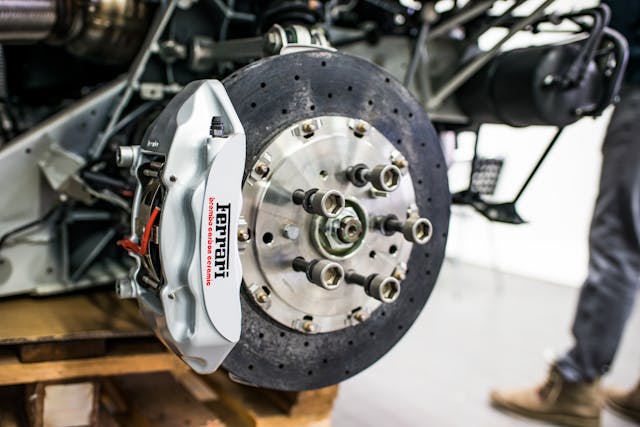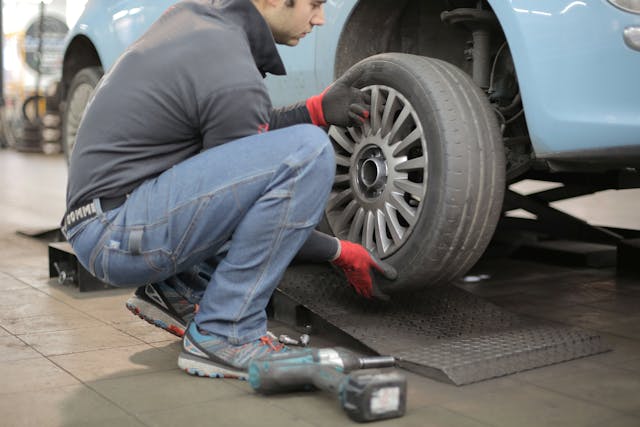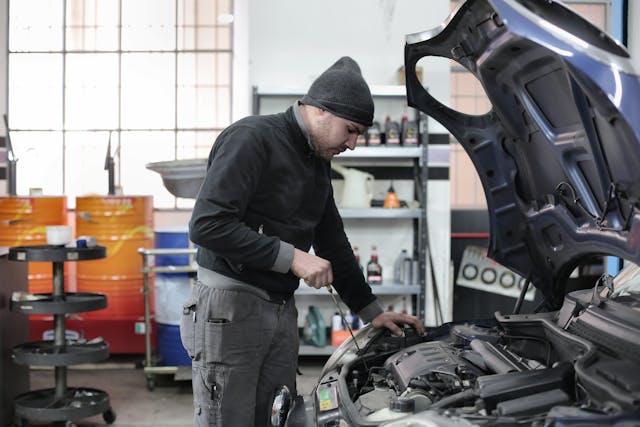The field of vehicle maintenance is changing at a faster rate than the automobile sector. The days of routine tune-ups and basic oil changes are long gone; modern technology is changing the way cars are maintained and serviced. The future of auto maintenance looks promising for increased effectiveness, dependability, and convenience, thanks to technologies like self-diagnosing systems and predictive maintenance algorithms. Let’s explore some of the cutting-edge methods and styles that are influencing how cars are maintained in the future.

1. Predictive Maintenance Systems: Preventing Emergencies in Time to Meet Needs
The creation of predictive maintenance systems is one of the biggest developments in auto repair. These systems use machine learning algorithms and data analytics to foresee possible problems before they arise. Predictive maintenance systems make use of patterns and trends found in data from sensors, onboard diagnostics, and previous maintenance records to determine when components are likely to fail. This proactive strategy minimizes downtime and lowers the chance of unplanned malfunctions by enabling prompt interventions.
2. Integration of the Internet of Things (IoT): Linking Vehicles to the Digital Age
The process of maintaining automobiles is being completely transformed by the use of Internet of Things (IoT) technologies. Cars are able to exchange real-time data on their performance, health, and maintenance requirements thanks to IoT-enabled sensors and gadgets installed throughout. Because of this connectedness, auto professionals and owners can monitor and manage cars more efficiently thanks to features like predictive analytics, over-the-air software upgrades, and remote diagnostics.
3. Telematics and Remote Monitoring: Tracking the Condition of Your Car
Vehicle health and performance may be remotely monitored thanks to telematics systems, which integrate informatics and telecommunications technology. Numerous parameters, including as tire pressure, fuel usage, engine diagnostics, and more, may be monitored by these systems. Telematics systems provide fleet managers and vehicle owners the real-time information they need to make educated choices regarding repairs and maintenance.
4. Applications of Virtual Reality (VR) and Augmented Reality (AR): Improving Technician Training and Repairs
Technologies like augmented reality (AR) and virtual reality (VR) are being used in auto repair and maintenance training. For instance, technicians may get real-time instruction and visualizations via AR-enabled smart glasses, which can help them identify and fix complicated problems. Through the use of VR simulations, technicians may hone their skills and efficiency by practicing maintenance processes in a virtual setting.
5. Autonomous Systems: Vehicles that Recognize and Report Problems
Autonomous vehicle health monitoring is entering a new age with the introduction of self-diagnosing technologies. These systems identify and assess any problems in real-time using sophisticated diagnostics and onboard sensors. The device may notify the driver and provide suggestions for upkeep or repairs if an issue is found. Some systems can even place parts orders and arrange appointments by speaking with service providers directly.

6. Blockchain Technology for Upkeep Records: Guaranteeing Trust and Transparency
The use of blockchain technology to keep safe and unchangeable maintenance records is now being investigated. Blockchain guarantees transparency, integrity, and confidence in a vehicle’s maintenance history by keeping track of maintenance and repair information in a decentralized, unchangeable ledger. This technology may increase trust between buyers and sellers by expediting the process of confirming maintenance data during car transfers and resale.
7. 3D Printing Replacement Parts: Manufacturing on-Demand
The development of 3D printing technology is completely changing how auto replacement parts are made. 3D printing makes it possible to produce unique components on demand, cutting lead times and prices, as opposed to depending on conventional manufacturing techniques and supply networks. This invention might revolutionize the way that repairs and maintenance are carried out, especially for rare or older cars for which components could be hard to come by.
8. Artificial Intelligence (AI) in Diagnostics: Harnessing Machine Learning’s Potential
Artificial Intelligence (AI) has the potential to completely transform auto maintenance because of its capacity to evaluate enormous volumes of data and spot trends that a person would miss. In order to identify irregularities and anticipate possible problems, AI-powered diagnostics systems may comb through sensor data, previous maintenance logs, and vehicle performance indicators. These systems constantly enhance their efficacy and accuracy by using machine learning algorithms, which allows for proactive interventions to stop malfunctions and maximize performance.
9. Robotic Assistants for Maintenance: Automated Partners in Repair
Autonomous maintenance helpers are becoming indispensable partners in the pursuit of accurate and productive vehicle repairs. From simple regular inspections and fluid checks to more intricate repairs and changes, these robotic devices are capable of doing a wide range of jobs. These robotic helpers, outfitted with sophisticated sensors, manipulators, and artificial intelligence algorithms, collaborate with human professionals to improve efficiency, precision, and safety during maintenance procedures.

10. Advanced Coatings and Materials: Improving Performance and Durability
Novel materials and coatings are being developed as a result of advancements in materials science, which enhance the performance and longevity of automotive components. These cutting-edge materials provide improved defense against wear, corrosion, and environmental degradation. Examples of these materials are self-healing polymers and corrosion-resistant metals. Carmakers may decrease the frequency of maintenance interventions and increase the lifetime of vital components by integrating these innovative materials into the design and manufacturing process of vehicles.
11. Nanotechnology for Protection and Lubrication: Reducing Wear and Friction
The development of nano-engineered coatings and additives is bringing lubrication and protection in auto maintenance to a new level. By reducing friction, wear, and heat production in engine components, these nanoscale materials provide very thin layers that increase engine component longevity and efficiency. Car makers may reduce the environmental effect of lubricants while increasing engine performance and reliability by using the special features of nanoparticles.
12. Augmented Reality (AR) Hands-On Repair Guides: Providing Guidance
The way professionals carry out repairs and maintenance activities is changing thanks to augmented reality (AR) maintenance guides. AR systems provide technicians real-time assistance and visualizations to help them with difficult processes by superimposing digital instructions and information onto the actual environment. This technology enhances the precision, safety, and efficiency of maintenance tasks, especially complex repairs that need for exact assembly and alignment.
13. Self-sufficient service stations: automated maintenance vehicles
A paradigm change in the provision of auto repair services is represented by autonomous maintenance vehicles. These mobile platforms can carry out a variety of maintenance activities independently since they are outfitted with robotic arms, diagnostic instruments, and 3D printers. Car manufacturers and service providers may provide on-demand repair services, cut down on wait times, and improve customer satisfaction by deploying these cars to key areas.
14. Eco-Friendly Maintenance Techniques: Long-Term Sustainable Solutions
Environmentally friendly maintenance techniques are becoming more and more popular in the vehicle repair industry in this day of growing environmental consciousness. These environmentally friendly substitutes for conventional auto maintenance procedures, such as water-based cleaning solutions and biodegradable lubricants, preserve vehicle performance and dependability without compromising on sustainability. Car owners and service providers may help ensure a cleaner, greener future for the automobile industry by adopting eco-friendly practices.
In conclusion, welcome to a new era of car maintenance.
Innovation, integration, and intelligence define automotive maintenance in the future. The vehicle maintenance industry is changing dramatically, from eco-friendly procedures to robotic maintenance assistants and AI-powered diagnostics. Car owners, manufacturers, and service providers may reach new heights of efficiency, dependability, and sustainability in automobile maintenance by adopting these innovations. Let’s use innovation to advance development, improve performance, and create a better future for the cars that move us ahead as we enter this new age of automotive maintenance.
Frequently Asked Questions (FAQ) – Examining Innovations and Technologies for the Future of Auto Maintenance
What is predictive maintenance, and why is it advantageous to owners of cars?
Predictive maintenance foresees possible problems in cars before they arise by using data analytics and machine learning algorithms. This proactive strategy lowers maintenance costs, helps to avoid unplanned failures, and increases the longevity of automobiles.
What role do machine learning and artificial intelligence (AI) play in auto maintenance?
Large volumes of data from sensors, diagnostics, and past records are analyzed by AI and machine learning algorithms to find trends and forecast possible problems in cars. Proactive interventions are made possible by these technologies, which also optimize maintenance plans for increased dependability and efficiency.
How do robotic maintenance assistants help technicians, and what are they?
Robotic maintenance assistants are automated devices that work with human workers to do a variety of maintenance jobs. They are outfitted with sensors, manipulators, and AI algorithms. In the end, these robots improve service quality and efficiency by increasing productivity, accuracy, and safety during maintenance procedures.
In what ways do maintenance manuals for augmented reality (AR) improve repair processes?
AR maintenance guides provide personnel real-time direction while doing repairs by superimposing digital instructions and visuals onto the actual environment. With this technology, maintenance activities may be performed more safely, accurately, and efficiently—especially when dealing with intricate jobs that call for precision and experience.
What part in automobile maintenance does nanotechnology play?
Advanced materials, coatings, and lubricants that improve the longevity, functionality, and efficiency of automotive components may be developed thanks to nanotechnology. By minimizing friction, wear, and heat production, nano-engineered materials increase engine longevity and lower maintenance needs.
What are autonomous cars for maintenance, and how are they going to transform auto repair services?
Mobile platforms with robotic arms, diagnostic equipment, and 3D printers that carry out maintenance jobs on their own are known as autonomous maintenance vehicles. By using cutting-edge technology and self-sufficient capabilities, these cars improve customer happiness, decrease wait times, and provide on-demand maintenance services.
What role do environmentally friendly repair techniques play in long-term, sustainable car maintenance?
To lessen the influence of maintenance operations on the environment, eco-friendly maintenance methods make use of sustainable substitutes such biodegradable lubricants and water-based cleaning solutions. These methods help the automobile sector have a cleaner, greener future by minimizing emissions and promoting sustainability.
Do these technologies of the future still need to be developed or are they already available?
Car manufacturers and service providers are already using several of the technologies described, including AI diagnostics, AR repair manuals, and predictive maintenance systems. While some technologies are still in the early stages of research, others are already changing the auto maintenance scene and propelling the industry forward.
How can mechanics and vehicle owners keep up with these developments in auto repair?
Manufacturer updates, industry journals, and professional forums are good places for auto technicians and owners to remain up to speed on the latest developments in automotive care. Additionally, people may keep up with the most recent trends and advancements in the industry by participating in training programs, seminars, and workshops centered on developing technology.
What are the possible advantages of adopting these cutting-edge technology for both automobile owners and the sector at large?
Adopting cutting-edge technology for auto maintenance has several advantages, such as increased sustainability, lower maintenance costs, safer, more dependable vehicles, and more. In addition to propelling advancement, these advancements have the power to completely change the automotive sector and create a more intelligent, connected, and efficient future for both cars and their owners.